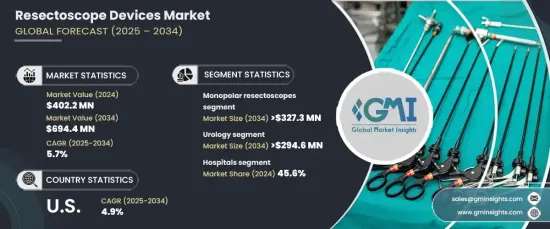PUBLISHER: Global Market Insights Inc. | PRODUCT CODE: 1665266

PUBLISHER: Global Market Insights Inc. | PRODUCT CODE: 1665266
Resectoscope Devices Market Opportunity, Growth Drivers, Industry Trend Analysis, and Forecast 2025 - 2034
The Global Resectoscope Devices Market, valued at USD 402.2 million in 2024, is anticipated to grow at a robust CAGR of 5.7% between 2025 and 2034. This growth is driven by the rising prevalence of urological and gynecological conditions and an increasing preference for minimally invasive surgical procedures. Continued advancements in surgical technologies and techniques are further propelling the adoption of resectoscope devices in healthcare facilities worldwide.

By type, the market is segmented into monopolar, bipolar, and hybrid resectoscopes. Monopolar resectoscopes are expected to see significant growth, with a projected CAGR of 5.5%, reaching a market value of USD 327.3 million by 2034. These devices are widely favored for their efficiency and cost-effectiveness, particularly in transurethral and gynecological surgeries. Their affordability compared to bipolar systems makes them an attractive option for healthcare providers in both developed and emerging regions, ensuring their sustained market dominance over the coming years.
| Market Scope | |
|---|---|
| Start Year | 2024 |
| Forecast Year | 2025-2034 |
| Start Value | $402.2 Million |
| Forecast Value | $694.4 Million |
| CAGR | 5.7% |
The market is also segmented by end use, including hospitals, clinics, ambulatory surgical centers, and other healthcare providers. Hospitals accounted for a leading 45.6% share of the market in 2024, bolstered by their advanced surgical infrastructure and integration of cutting-edge imaging technologies. The presence of specialized professionals such as urologists and gynecologists ensures precision and safety during procedures, solidifying hospitals as the top choice for resectoscope device applications. Their ability to handle both complex and minimally invasive surgeries further enhances their position in the market.
In the United States, the resectoscope devices market was valued at USD 148.7 million in 2024, with a projected CAGR of 4.9% through 2034. The country's well-established healthcare infrastructure, widespread adoption of advanced surgical equipment, and the presence of key market players are driving its dominance. Additionally, factors such as increased healthcare spending, a growing elderly population, and rising demand for minimally invasive surgeries contribute to sustained market growth in the U.S.
Table of Contents
Chapter 1 Methodology and Scope
- 1.1 Market scope and definitions
- 1.2 Research design
- 1.2.1 Research approach
- 1.2.2 Data collection methods
- 1.3 Base estimates and calculations
- 1.3.1 Base year calculation
- 1.3.2 Key trends for market estimation
- 1.4 Forecast model
- 1.5 Primary research and validation
- 1.5.1 Primary sources
- 1.5.2 Data mining sources
Chapter 2 Executive Summary
- 2.1 Industry 3600 synopsis
Chapter 3 Industry Insights
- 3.1 Industry ecosystem analysis
- 3.2 Industry impact forces
- 3.2.1 Growth drivers
- 3.2.1.1 Rising prevalence of urological and gynecological disorders
- 3.2.1.2 Technological advancements
- 3.2.1.3 Shift towards minimally invasive procedures
- 3.2.2 Industry pitfalls and challenges
- 3.2.2.1 High costs of advanced devices
- 3.2.1 Growth drivers
- 3.3 Growth potential analysis
- 3.4 Regulatory landscape
- 3.5 Reimbursement scenario
- 3.6 Technology landscape
- 3.7 Gap analysis
- 3.8 Porter's analysis
- 3.9 PESTEL analysis
- 3.10 Future market trends
Chapter 4 Competitive Landscape, 2024
- 4.1 Introduction
- 4.2 Company matrix analysis
- 4.3 Company market share analysis
- 4.4 Competitive analysis of major market players
- 4.5 Competitive positioning matrix
- 4.6 Strategy dashboard
Chapter 5 Market Estimates and Forecast, By Type, 2021 – 2034 ($ Mn)
- 5.1 Key trends
- 5.2 Monopolar resectoscopes
- 5.3 Bipolar resectoscopes
- 5.4 Hybrid resectoscopes
Chapter 6 Market Estimates and Forecast, By Application, 2021 – 2034 ($ Mn)
- 6.1 Key trends
- 6.2 Urology
- 6.3 Gynecology
- 6.4 General surgery
- 6.5 Other applications
Chapter 7 Market Estimates and Forecast, By End Use, 2021 – 2034 ($ Mn)
- 7.1 Key trends
- 7.2 Hospitals
- 7.3 Clinics
- 7.4 Ambulatory surgical centers
- 7.5 Other end users
Chapter 8 Market Estimates and Forecast, By Region, 2021 – 2034 ($ Mn)
- 8.1 Key trends
- 8.2 North America
- 8.2.1 U.S.
- 8.2.2 Canada
- 8.3 Europe
- 8.3.1 Germany
- 8.3.2 UK
- 8.3.3 France
- 8.3.4 Spain
- 8.3.5 Italy
- 8.3.6 Netherlands
- 8.4 Asia Pacific
- 8.4.1 China
- 8.4.2 Japan
- 8.4.3 India
- 8.4.4 Australia
- 8.4.5 South Korea
- 8.5 Latin America
- 8.5.1 Brazil
- 8.5.2 Mexico
- 8.5.3 Argentina
- 8.6 Middle East and Africa
- 8.6.1 South Africa
- 8.6.2 Saudi Arabia
- 8.6.3 UAE
Chapter 9 Company Profiles
- 9.1 Advin Urology
- 9.2 bissinger
- 9.3 ESC Medicams
- 9.4 ENDOMED SYSTEMS
- 9.5 JDmeditech
- 9.6 KARL STORZ
- 9.7 LEPU MEDICAL
- 9.8 OLYMPUS
- 9.9 Orion Medical
- 9.10 Richard Wolf
- 9.11 Stryker
- 9.12 TONTARRA




